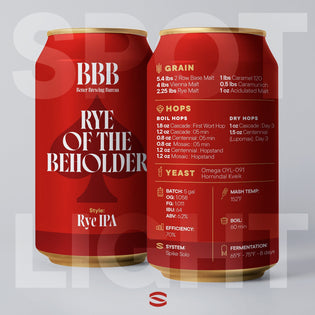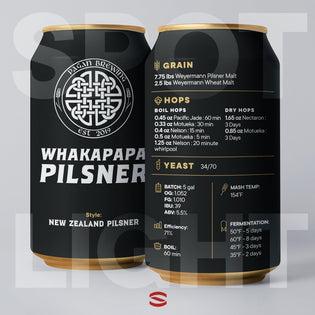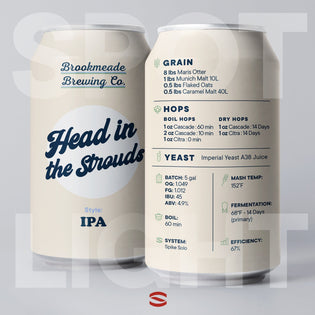The Brewer: Benevolent Brew Works
Hi, I’m Dave! I’ve been brewing for over 12 years and got started the same way as most do—with a small pot on a stove, a plastic bucket, and an extract kit. I was hooked immediately and dove in head first with internet research, brewing books, blogs, magazines, and hands-on brewing experimentation.
Over the years I’ve added more and more equipment and automation, but Spike equipment is at the heart of my operation. I currently use a 3-vessel custom HERMS electric brewing setup using 3 Spike kettles, a CF5, and a CF10 fermenter. I even have two of the old-school V2 kettles with the old dog logo, although one has since been retired.

The Beer: New Zealand Pilsner
Pils Death Do Us Part is a New Zealand Pilsner and is a perfect mix of a classic, crispy, drinkable lager brought into the modern era with new varieties of New Zealand hops. A great warm weather beer!
The name comes from the wedding vow play on words. The first batch was one of four beers brewed and served for a wedding of two friends.

The Recipe: Pils Death Do Us Part

INGREDIENTS
GRAIN
- 7.25 lbs Belgian Pilsner
- 1 lbs Malted Wheat
- .75 lbs Cara-Pils
HOPS
- Boil hops: .6 oz Motueka - 0:60 min
- Boil hops: .4 oz Pacific Jade - 0:30 min
- Boil hops: .4 oz Nelson Sauvin - 0:15 min
- Boil hops: .25 oz Nelson Sauvin - 0:05 min
- Boil hops: .15 oz Motueka - 0:05 min
- Boil hops: .15 oz Pacific Jade - 0:05 min
YEAST
- Imperial Urkel L28

INSTRUCTIONS
BATCH SIZE: 5 gal
OG: 1.05
FG: 1.01
IBU: 34
ABV: 5%
EFFICIENCY: 72%
MASH TEMP: 149 ºF
BOIL: 75 min
FERMENTATION: 54º F - 30 Days
SYSTEM: Custom 3 Vessel Spike HERMS
Pro Tips
1. Mash at 149º F
The grain bill is kept simple with a little malted wheat for flavor and Cara-Pils added to assist with more head retention. Mashing at 149º F allows for a more fermentable wort, giving the yeast plenty to munch on which drives a lower FG and dry finish.
2. Don’t Get Too Fancy
Motueka, Nelson Sauvin, and Pacific Jade pair extremely well in this recipe. The key here is to not get overly fancy and let the beer do the talking.
3. Be Aware of Fermentation Temperature
Fermenting at ranges of 54-56 keeps the lager yeast happy. To avoid off-flavors, it’s important to do a diacetyl rest for a few days once gravity has reached the halfway mark between OG and FG.
To perform this rest, I raise the fermentation temp in my CF5 or CF10 to roughly 68 for a few days.
I generally keep it here until any buttery flavors disappear from samples taken. At that point, temperatures are slowly dropped by a few degrees per day until it reaches a final resting temp of 38. There is no set time I hold the beer at this point—I let the beer tell me when it is ready!

Cheers!
Dave – Benevolent Brew Works
Spike Summarizes: All Things Pilsner Beer
What Is Pilsner Beer?
If you're in the mood for a refreshing and bubbly beer, you might want to try Pilsner! This type of lager is famous for its light and crisp taste, thanks to the pale malts and bottom-fermenting yeast used in its brewing.
It's a popular choice in bars and restaurants worldwide, and it's easy to see why. Pilsner is perfect for summer sipping and pairs well with all kinds of dishes, from spicy Mexican cuisine to light salads.
So whether you're a die-hard Pilsner fan or itching to try something new, rest assured there's a Pilsner beer for everyone.
What Are the Characteristics of Pilsner Beer?
Let's break down the key features that make a Pilsner beer stand out:
- Light golden color, resulting from the pale malt used in brewing
- Mild flavor with a slight hop aroma and a crisp, dry finish
- Balanced hop bitterness and malt sweetness
- Alcohol content ranging from 4-6% ABV
- Brewed using pale malt, hops, yeast, and water
- Typically served cold in a tall, slender pilsner glass, designed to showcase its color, carbonation, and foam retention
With its mild flavor and easy-drinking nature, Pilsner is perfect for those who want a lighter beer that still packs a flavorful punch.
What Is the History of Pilsner Beer?
It all started in the mid-19th century in Plzeň, Bohemia (which is now known as the Czech Republic). A Bavarian brewer named Josef Groll brewed the very first Pilsner back in 1842, using pale malts and a special type of hops from the nearby Žatec region.
The result was a refreshing beer with a light color and crisp taste that quickly became popular all over Europe and beyond!
The name "Pilsner" actually pays tribute to its birthplace, Plzeň. And nowadays, any beer brewed in the same style as the original is also referred to as a Pilsner.
What Are the Types of Pilsner Beer?
Now, let’s dive into the four main types of Pilsner beer: American, Belgian, Czech, and German.
American Pilsner
American Pilsner is a light-bodied, golden lager that’s brewed with pale malt and noble hops, creating a crisp flavor with just a touch of floral aroma. Perfect for those lazy summer afternoons or as a go-to brew, this style is fermented at lower temperatures to achieve a clean, smooth taste.
Belgian Pilsner
Belgian Pilsner delights the senses with its light golden color and distinctive flavor profile, thanks to the unique Belgian yeast strain. The result? A spicy, herbal aroma that sets this pilsner apart.
Brewed with two-row barley, wheat, and hops, Belgian Pilsners boast a bubbly texture and a light, floral hop character. Pair this easy-drinking beer with light salads, seafood, or grilled meats, and let the good times flow.
Czech Pilsner
Czech Pilsner, the style that started it all, hails from the city of Pilsen in the Czech Republic. A light-bodied, golden beer with a pleasant, mildly sweet maltiness, Czech Pilsners are brewed with just four ingredients: barley malt, hops, water, and yeast.
The Saaz hops from the Czech Republic lend a moderate hop aroma and flavor, with hints of spiciness, grassiness, or herbal notes. If you're craving a true classic, look no further than Czech Pilsner.
German Pilsner
German Pilsner, also known as German Pils, is a timeless brew with a light color, crisp flavor, and moderate bitterness. This style is brewed with a blend of barley and hops and fermented with a lager yeast strain.
They offer a clean, refreshing taste that has beer aficionados coming back for more. Pair it with grilled meats, fish, salads, or spicy dishes, and you've got yourself a winning combo.
What Do I Pair With a Pilsner?
Pilsner's mild, slightly sweet flavor and light body make it a versatile choice for food pairings:
- Seafood: Grilled salmon, steamed lobster, and shrimp
- Cheeses: Sharp cheddar, creamy brie, or gouda work well
- Meats: Grilled steak or pork dishes, like pulled pork sandwiches or pork chops
- Desserts: Anything sweet should pair nicely
What Is the Difference Between a Pilsner and a Lager Beer?
Pilsner beer is brewed using a bottom-fermenting yeast while lagers are brewed using a top-fermenting yeast, which gives each beer a distinct flavor profile. Pilsner beers also tend to be light and crisp with a slightly sweet, malty flavor, while lagers are generally more full-bodied with a slightly bitter, hoppy taste.






